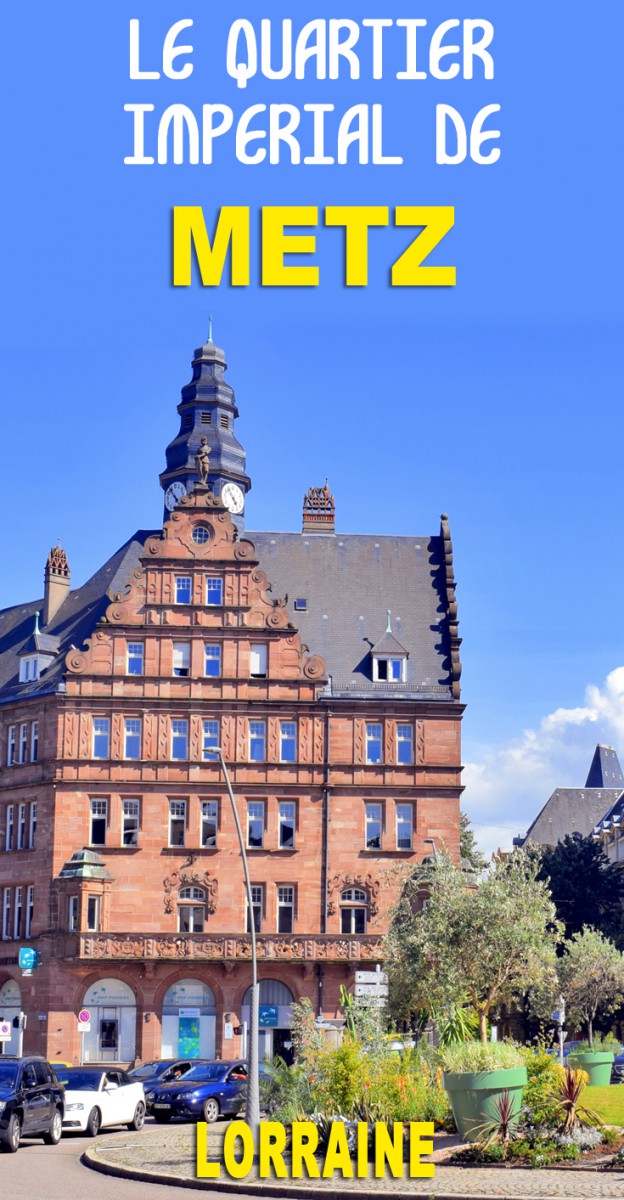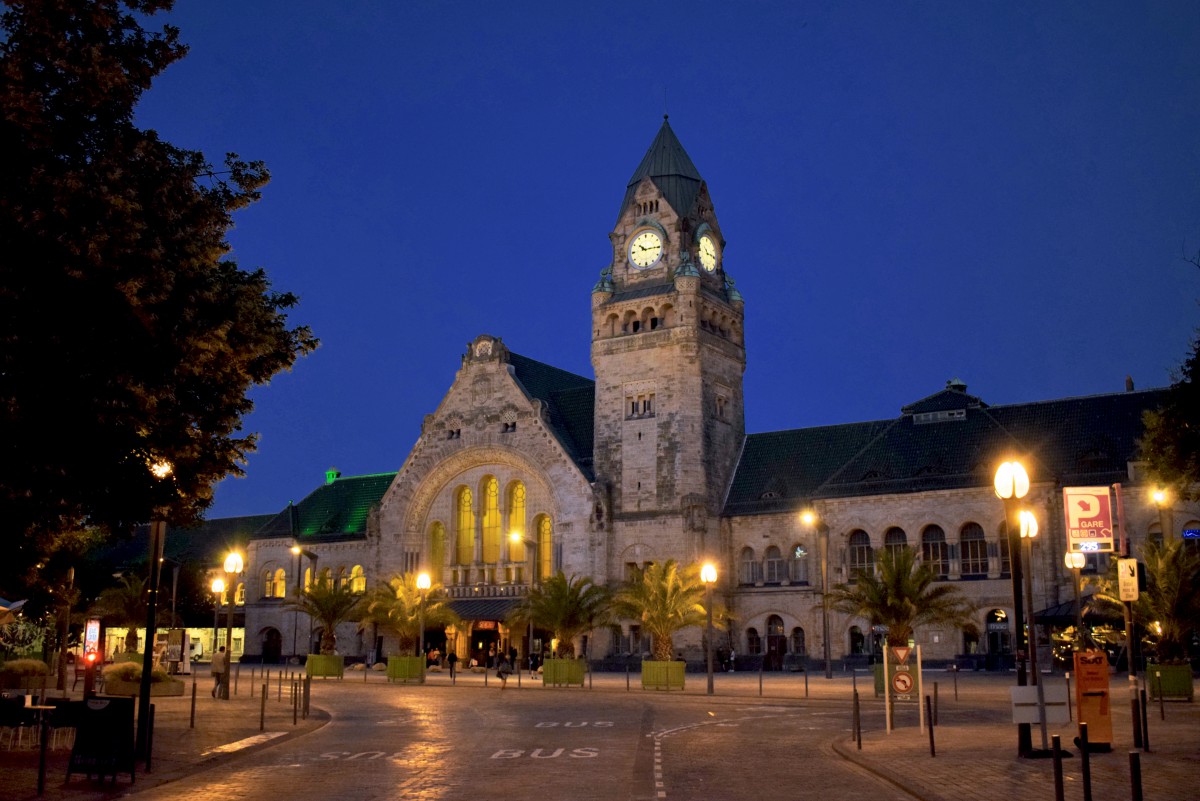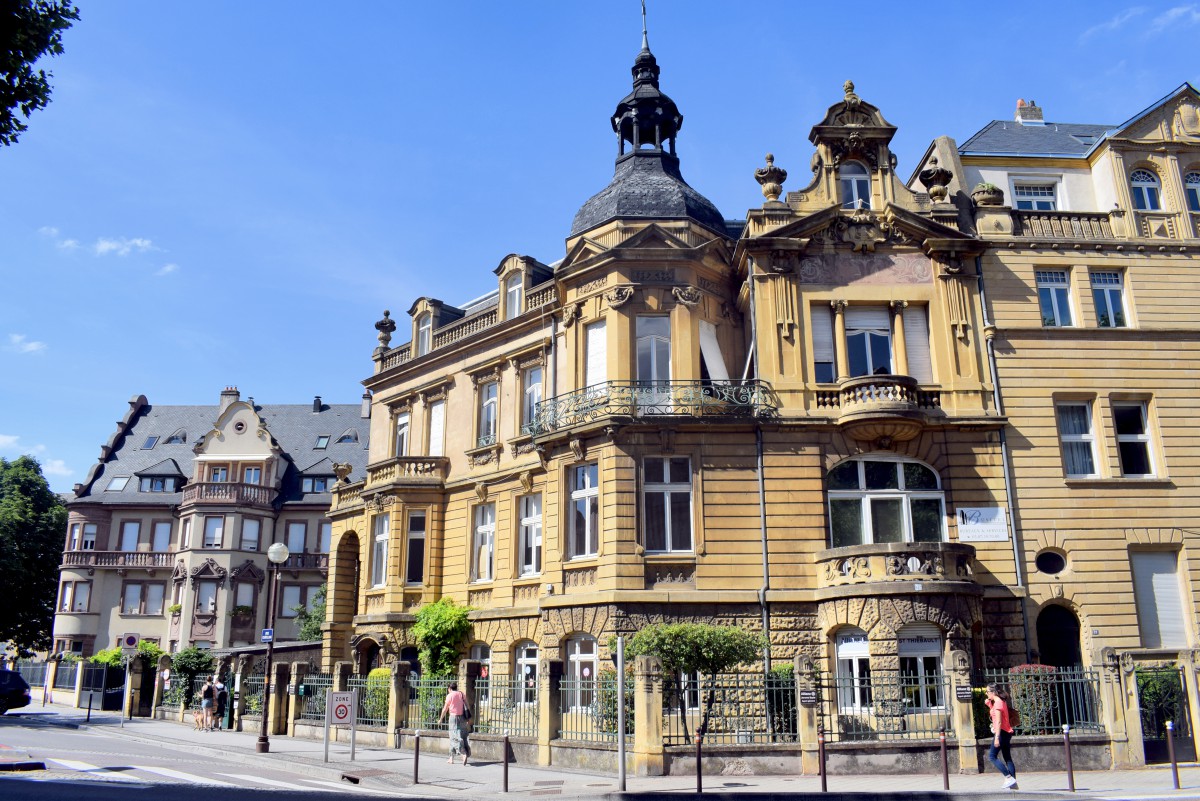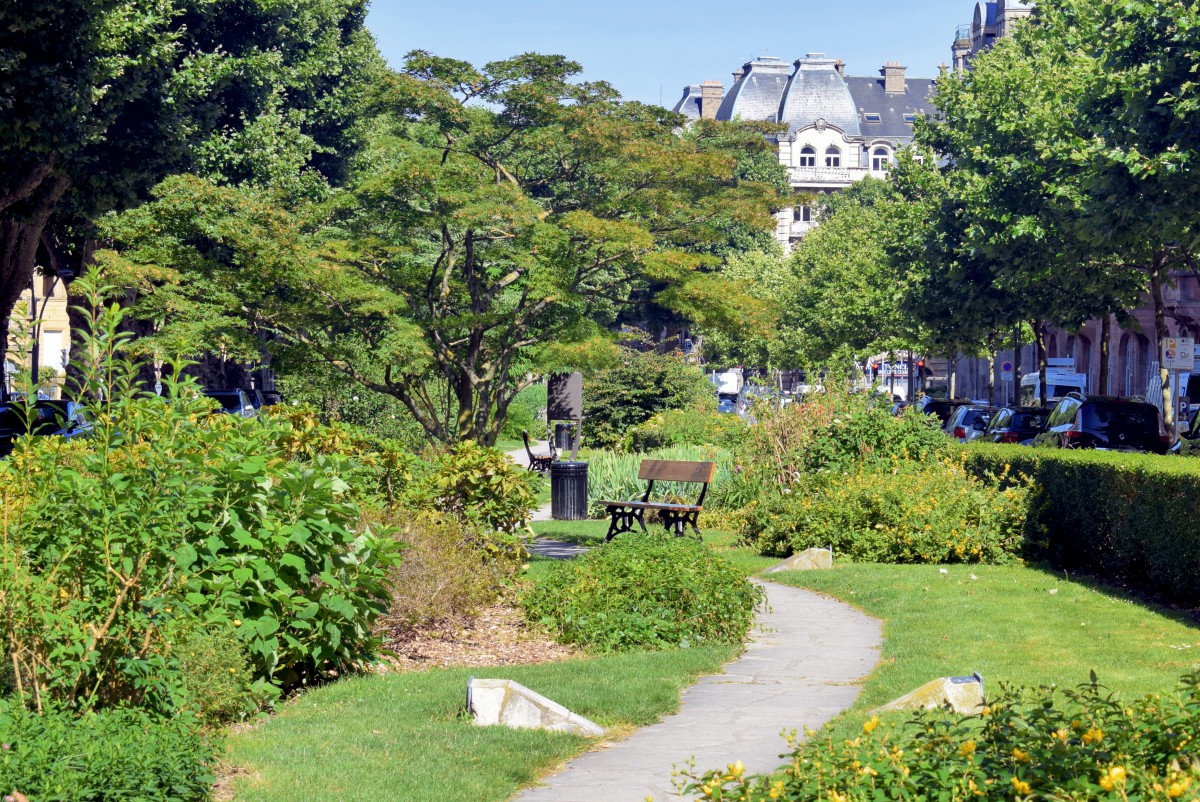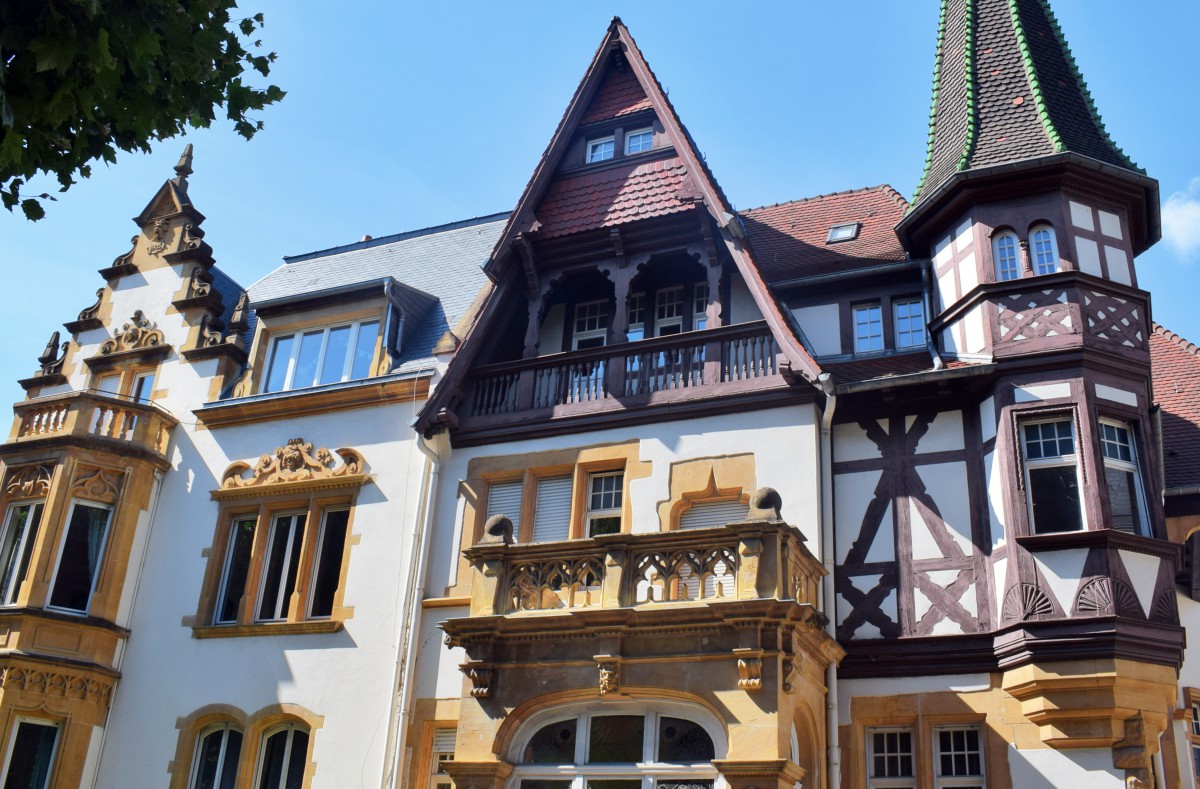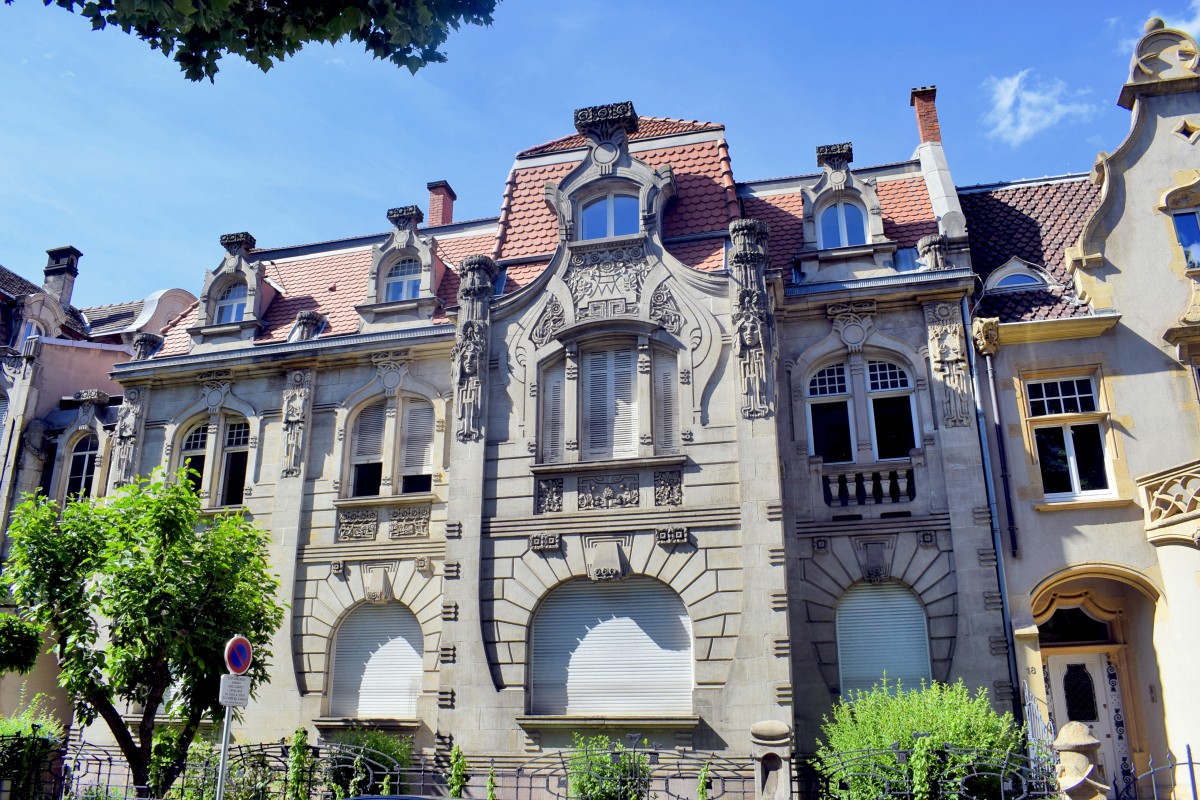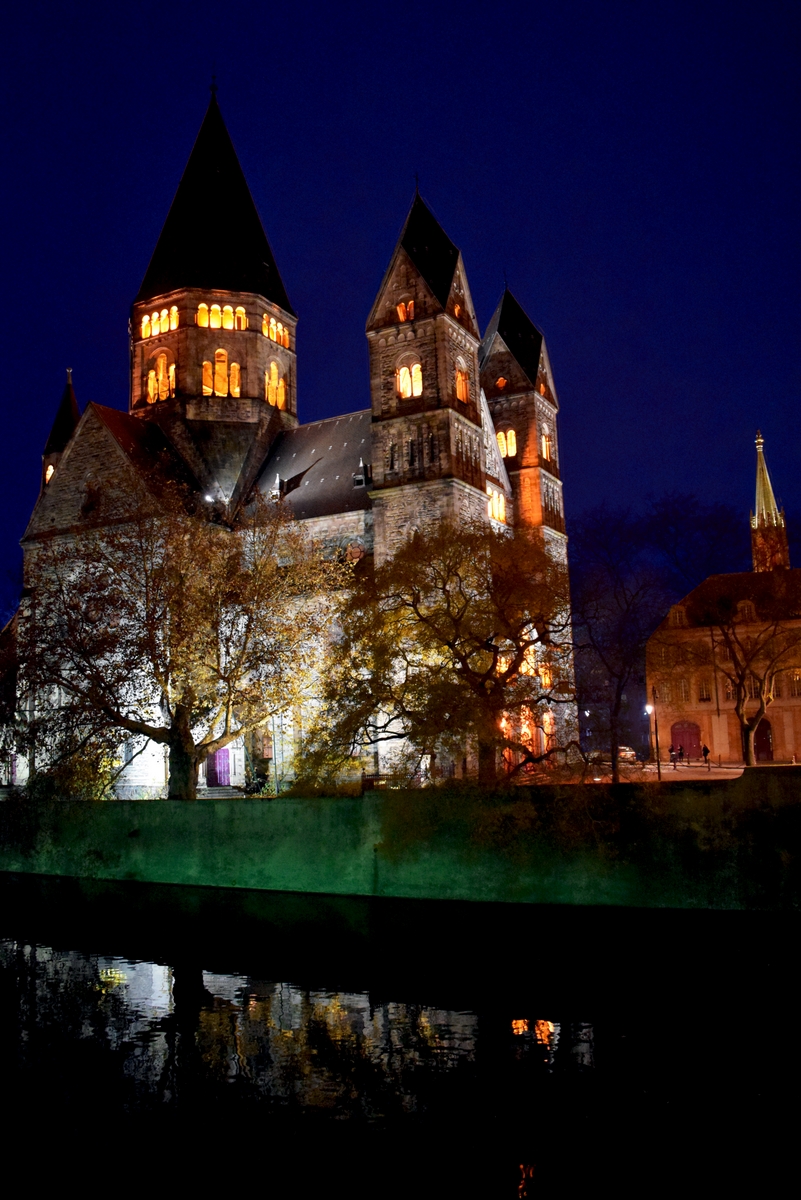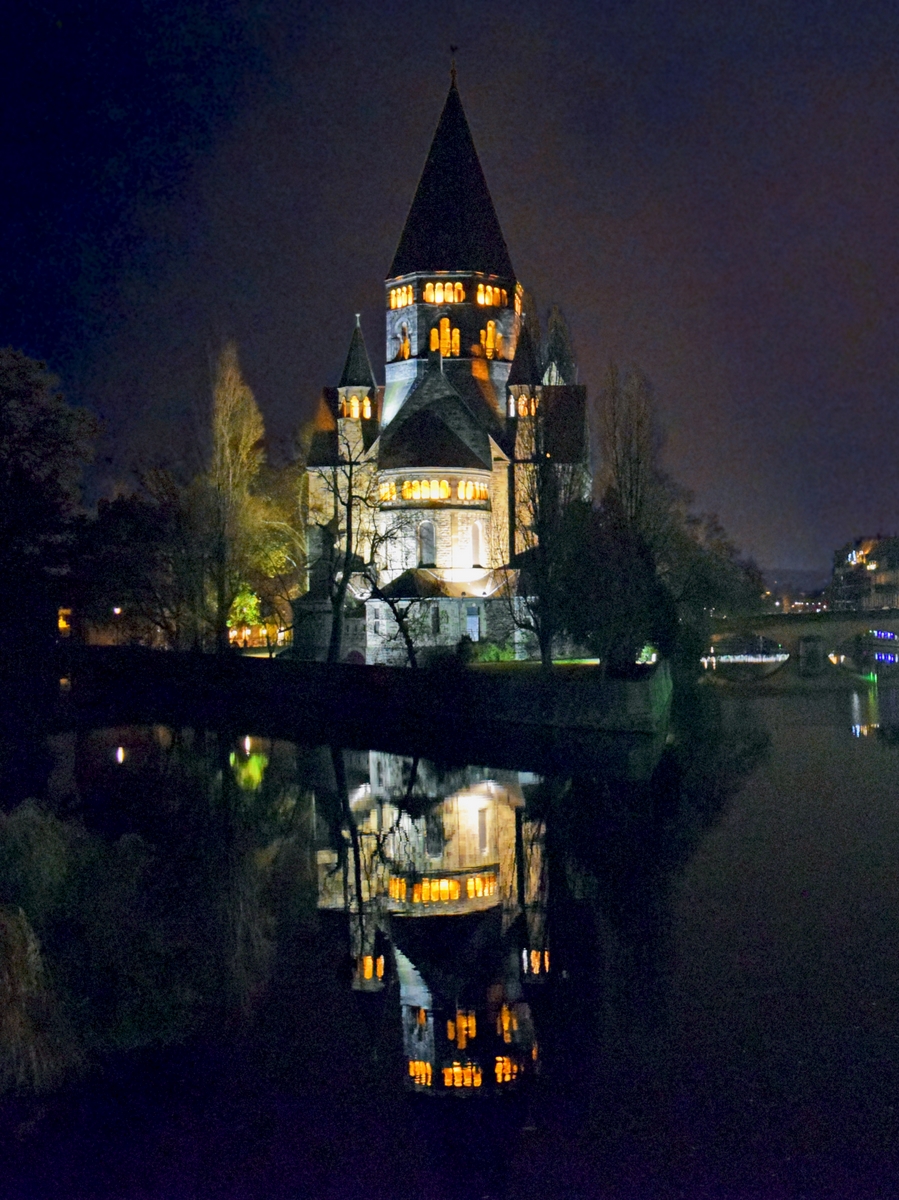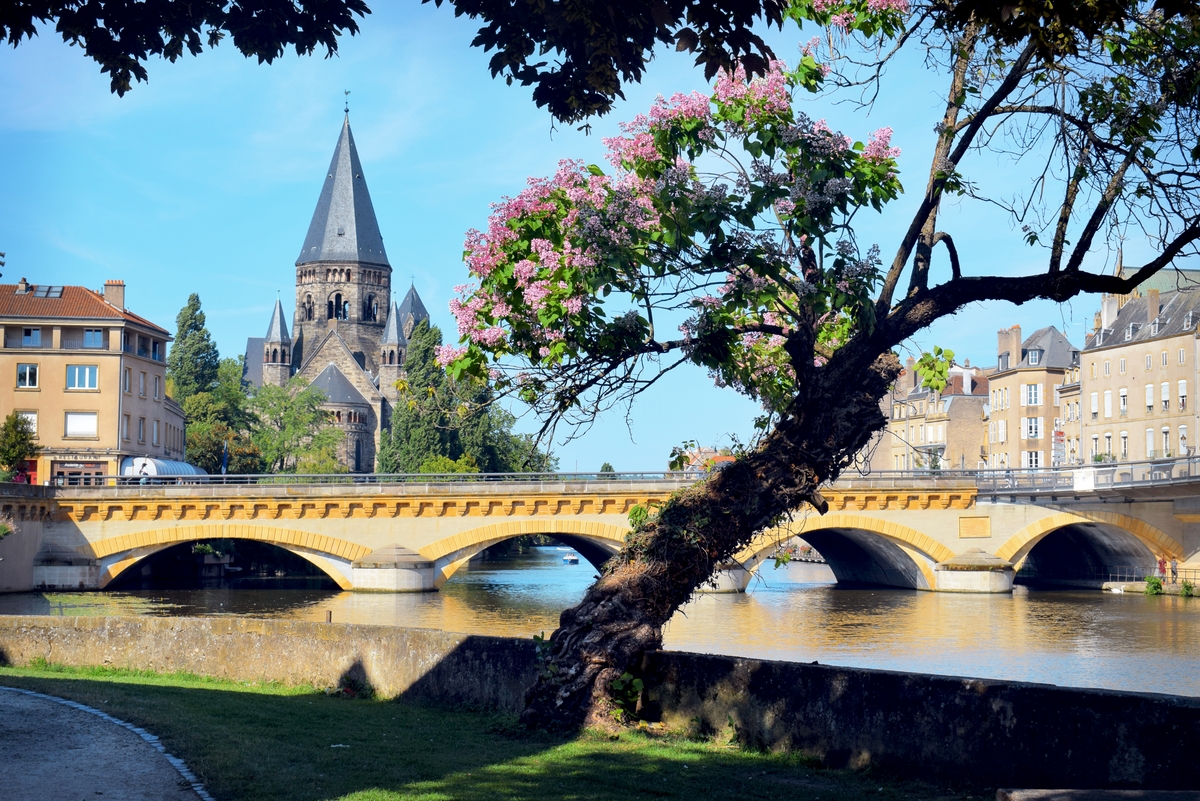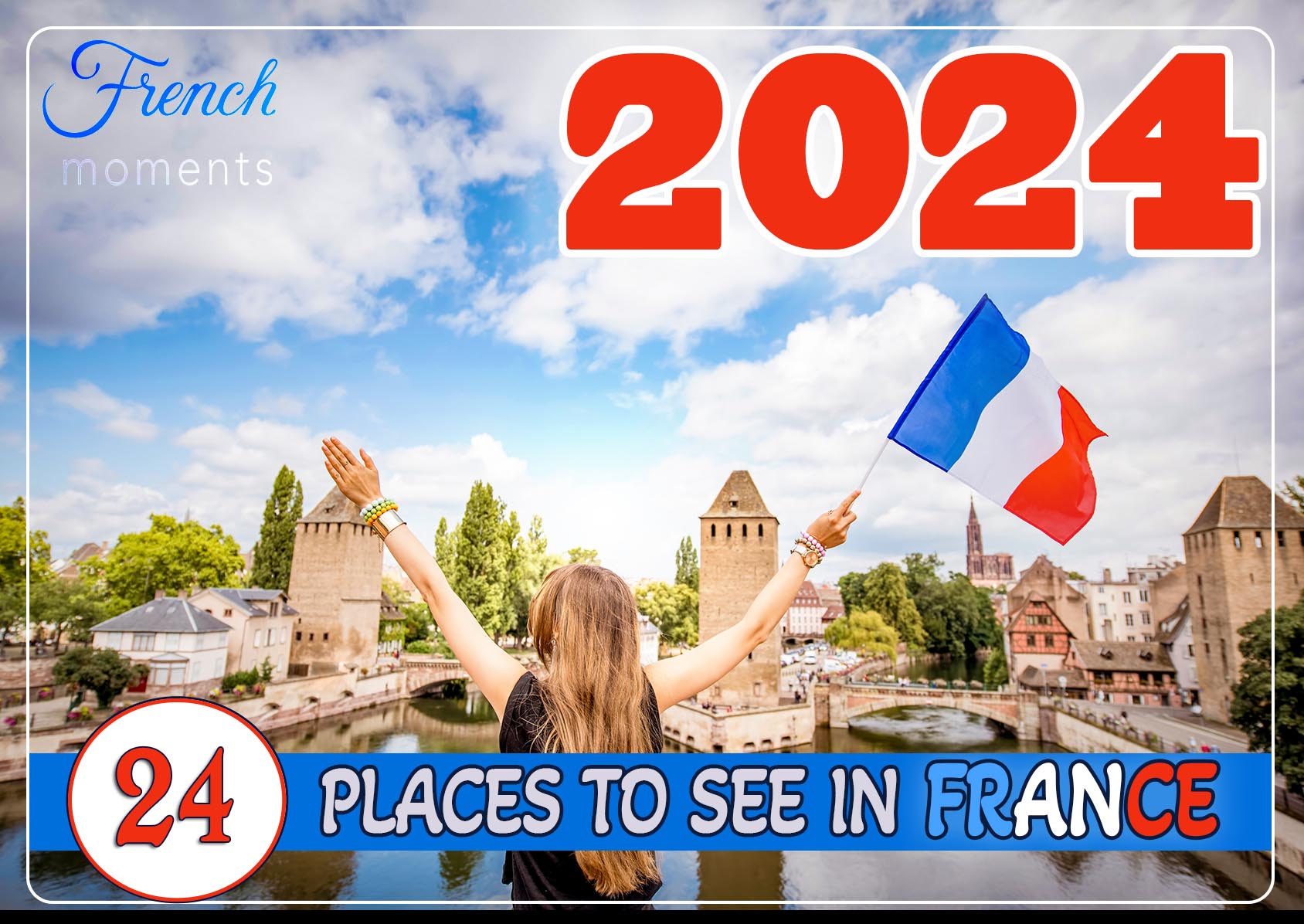The Metz German Imperial District was created following the Franco-Prussian War of 1870-71 when the fate of Metz changed dramatically. The end of the war saw the city and its département (Moselle) annexed by Bismarck into Germany.
Metz German Imperial District: Historic Overview
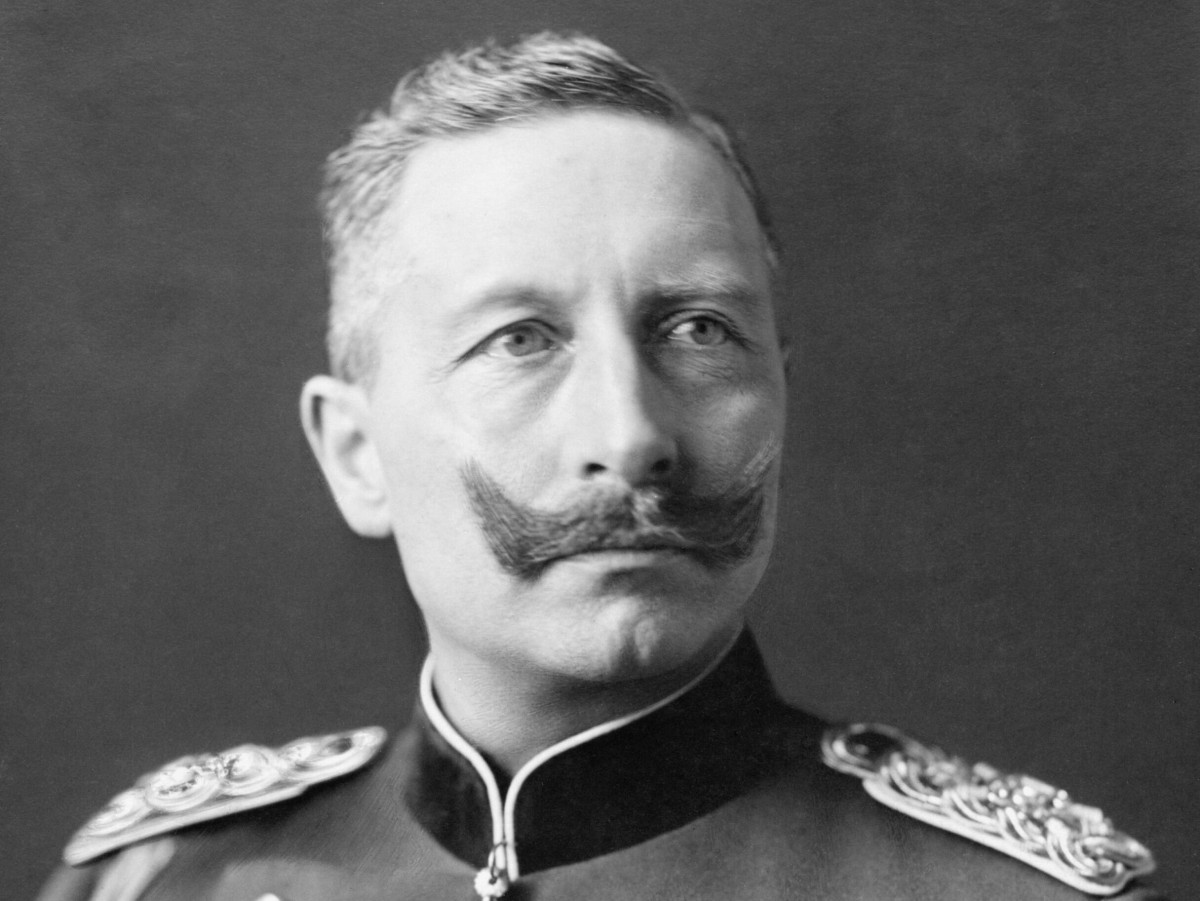
The dismantlement of Metz’s medieval ramparts by the Germans in 1903 led to the creation of a new district within the city: the German Imperial District (in French: Quartier Impérial Allemand). Many reasons were put forward to justify the new urban planning:
- Emperor Wilhelm II wished to “Germanify” the city by creating “another city” within the existing city, shaped by a distinctive Germanic architecture. The buildings erected in the new district had to affirm the place of Metz within the German Empire, hence glorifying the imperial power. The Kaiser thought that surrounding the local population with German-style buildings would make them feel more pro-German. He personally oversaw the new town planning project, located around the railway station, to the South of the Old Town, in order to make Metz a model of German prestige and elegance.
- The army required a well-planned district strategically designed around a new railway station, which would be built with the prospect of a war between Germany and France in mind.
- The municipality was willing to transform Metz into a new modern city, a symbol of dynamism.
- The aristocracy and the bourgeoisie were the happy recipients of the urban planning as they would dwell in luxurious manors and apartment blocks adapted to their lifestyle. This new but remarkable architectural example was commissioned by an architect from Berlin, Kröger, who erected many imposing buildings in the Rhenish tradition along Metz’s Grand Boulevards.
- The architects had to respond to two challenges in planning the new urban district: the requirement of the military strategies and the erection of a functional and artistic ensemble.

However, the First World War brought the rest of the plans to a definitive stop and only the Imperial District, covering some 160 hectares (8% of Metz’s surface), was nearly completed.
When built, the new district did not meet the approval of Lorraine people, such as writer Barrès, for obvious political reasons.
It is no longer the case today, as the quality of its urban planning and architecture is at last appreciated without any political resentment towards Germany. For sure, many Messins (the people of Metz) would never think of their city without its iconic railway station!

German architect Konrad Wahn justified his urban planning in Metz as an idea of urban art in its whole: each element of the city should be aesthetic and coherent towards the whole, as well as keeping a great diversity of artistic and architectural influences. To show how pertinent were the works of Wahn, the French completed the works after 1918, despite the sensitive political post-war context.
That’s why if you stroll around the district, you will discover an inconsistent – even contradictory – blend of architecture, from art deco (Jugendstil) and neo-Romanesque mansions to mock-Bavarian farmhouses.
The “Pierre de Jaumont” which was traditional – and extensively – used so far everywhere was replaced with stones used in the Rhineland: pink and grey sandstone, granite and basalt.
Some large neo-Romanesque buildings typical of the German Empire successively appeared in the city: the water tower (1908), the railway station (1908), the post office (1911), the protestant temple of the German garrison (1881), the Temple Neuf (1904) or the Palais du Gouverneur (1905).
The Railway Station of Metz

The railway station is by far the most impressive building in the Imperial district. With its large dimensions (300m long), it served as a display of the German’s intentions to establish Metz as a prestigious German city, strengthened by its important garrison of 25,000 soldiers before 1914.
Designed by architect Jürgen Kröger, it took from 1905 to 1908 to complete and replaced the existing, smaller building.
At completion, the station was the flagship of the new town erected by the Germans. The vast building carries an extraordinary symbolic meaning, praising the power of the German Empire.
Its neo-Romanesque style imposed by the Kaiser is a reminder of the Ottonian Empire with its distinctive features: round-arched windows, ornamental foliates, gateways decorated with lions, monster creatures, screen walls, figural capitals…
The Departures and Arrivals Halls

The station echoes the shape of the church (at the departure hall with the clock tower) and an imperial palace (at the arrivals hall and the ‘buffet’).
It recalls the religious and temporal powers of the Holy Roman emperor during the Middle-Ages.

The Imperial eagle used to dominate the great window frame in the departure hall. It is still surrounded by a depiction of a woman weaving and a warrior.
These symbols of industry and war justified the expansion endeavours of the Empire. The Metz coat of arms panel later replaced the eagle once the city became French again.
The Imperial Suite
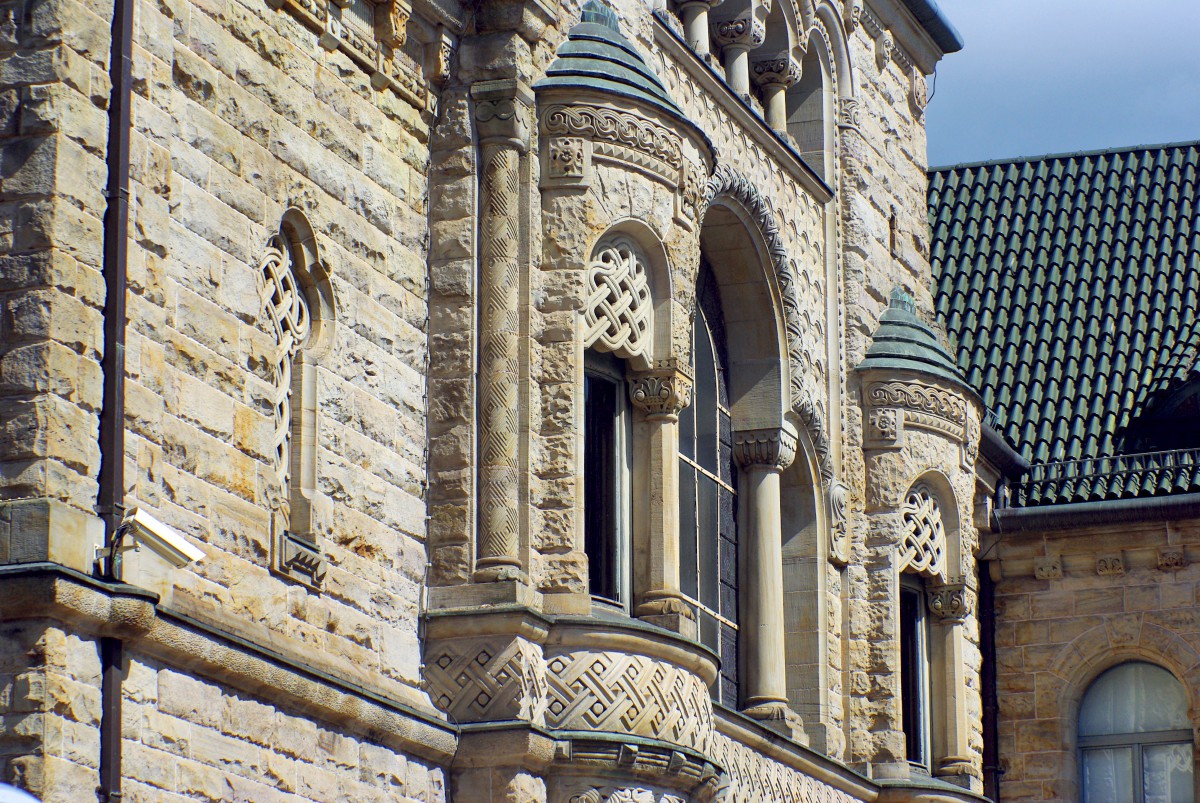
The Imperial Suite is decorated with a stained glass of Charlemagne sitting on his throne in Aachen, hence evoking the Carolingian Empire.
![Metz Railway Station © Fab5669 - licence [CC BY 3.0] from Wikimedia Commons](https://frenchmoments.eu/wp-content/uploads/2012/11/Charlemagne-stained-glass-Metz-Railway-Station-©-Fab5669-licence-CC-BY-3.0-from-Wikimedia-Commons.jpg)
The reception hall was initially dedicated to the Emperor on his visit to Metz. The hall served to welcome the Kaiser before he entered the city. A second stained-glass window showing the Imperial eagle was dismantled after 1918, as the French found it had too Germanic a connotation.
The figural capitals
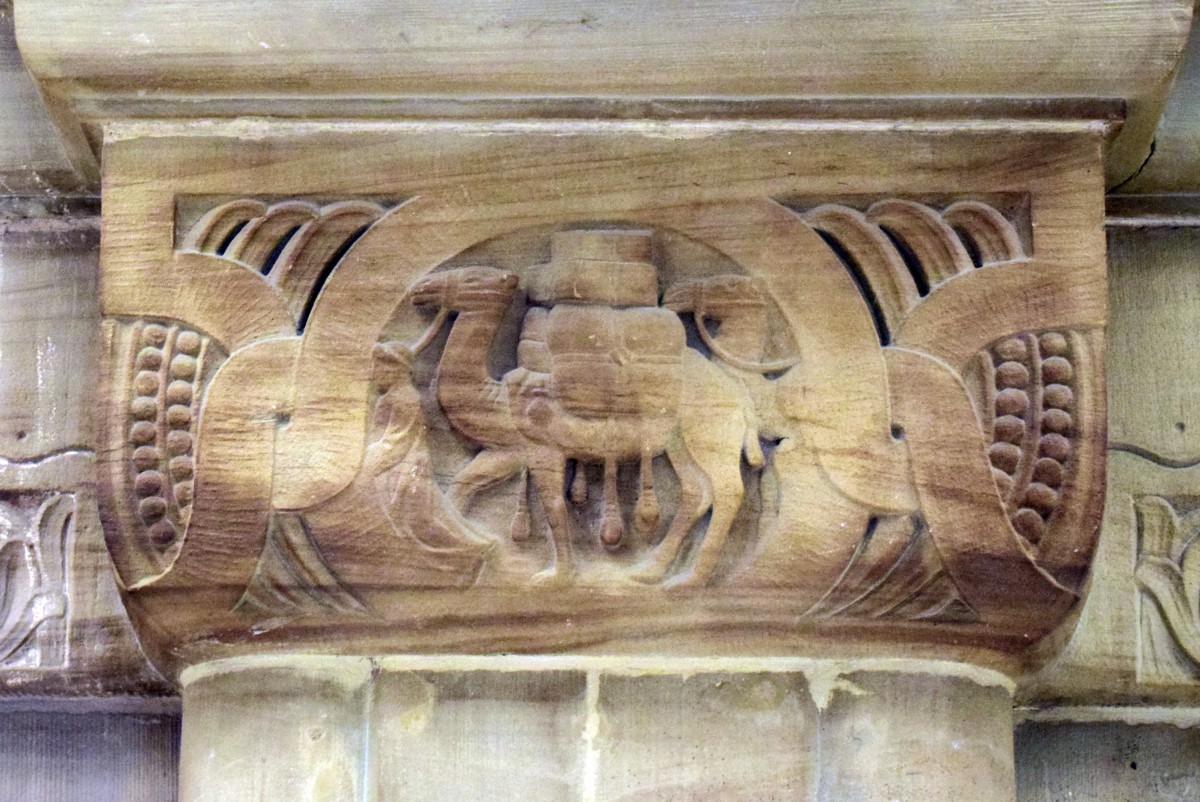
Some of the figural capitals represent the technical progress of the time (car, zeppelin), the social progress (retired railwaymen, occupational health) and the colonial extension of Germany (with the help of camels). Other sculptures tell of the great themes of Christendom.
The station’s clock tower
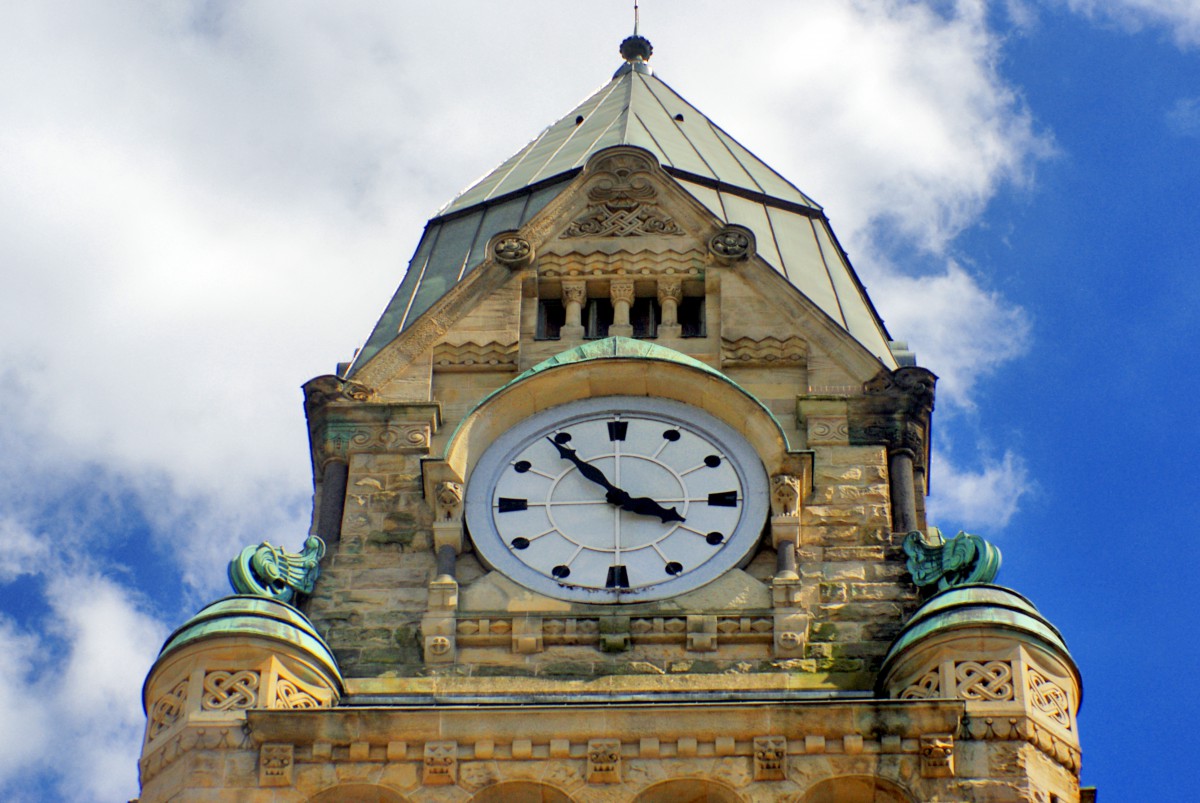
The clock tower soars 40 metres above the railway square. The design is said to have been drafted by the Kaiser himself. The statue of the knight Roland at the angle of the clock tower which represented the imperial protection over Metz, changed heads four consecutive times depending on the political regimes.
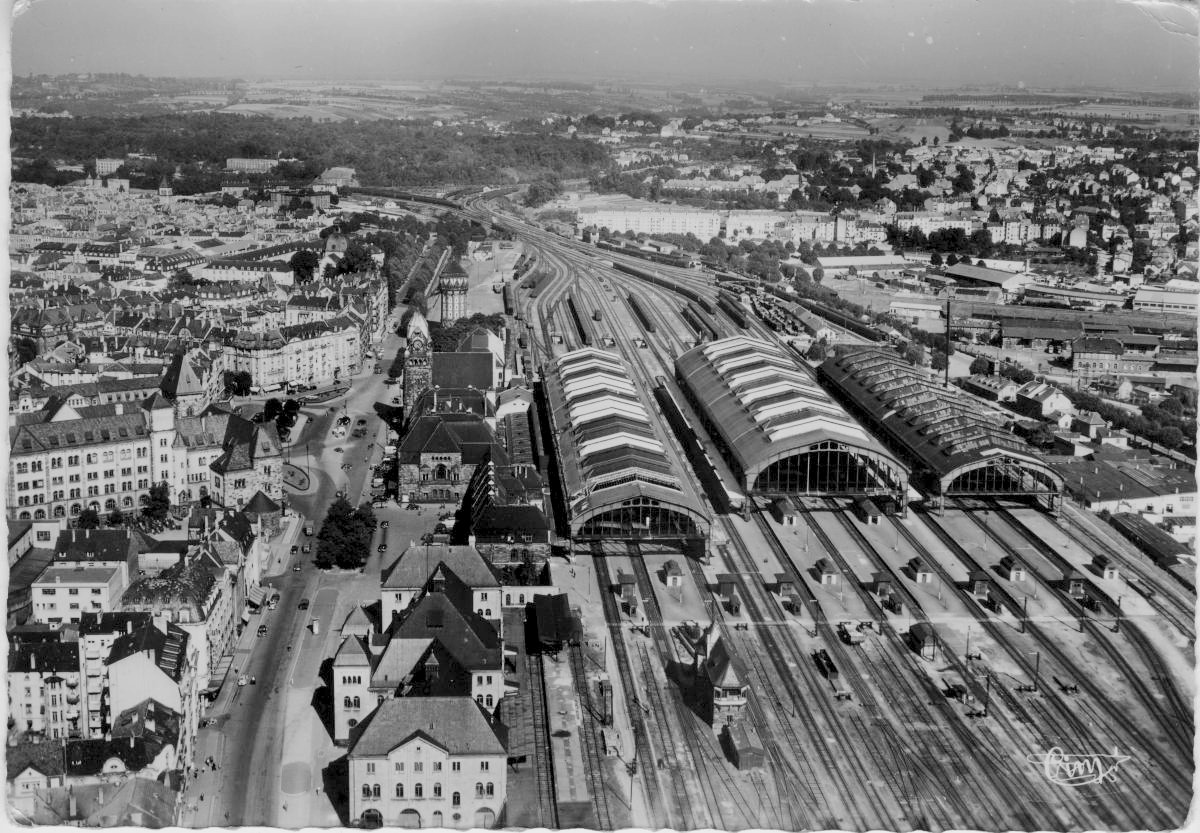
Beyond all these symbolic features, the highly functional design of the station was overseen by the army to suit the strategy of the Schlieffen plan. The 25,000 soldiers residing in Metz had to be able to board the trains with their equipment and no less than 750,000 horses within 24 hours towards fronts in France or Russia.
This explains the surprising dimensions of the station – the longest in France – with its 300-metre long facade. If the station was said to be oversized to the civil needs of the 1900s, it has become totally suited to today’s standards in particular with the new TGV-Est line to Paris.
The roof is covered with green varnished tiles, with a few elements in copper.
The wide platforms were covered by three metallic glass halls which were unfortunately replaced in 1974 by a concrete car park.
The facades and the roof on the square side, the departure hall as well as the ‘salon d’honneur’ and the ‘buffet’ were listed as historic monuments in 1975. The inside of the station was intensively renovated prior to the arrival of the TGV-Est Européen on the 10th of June 2007.
The new pedestrianised square in front of the station is bordered by beautiful lamp posts designed by Philippe Starck.
The Central Post Office
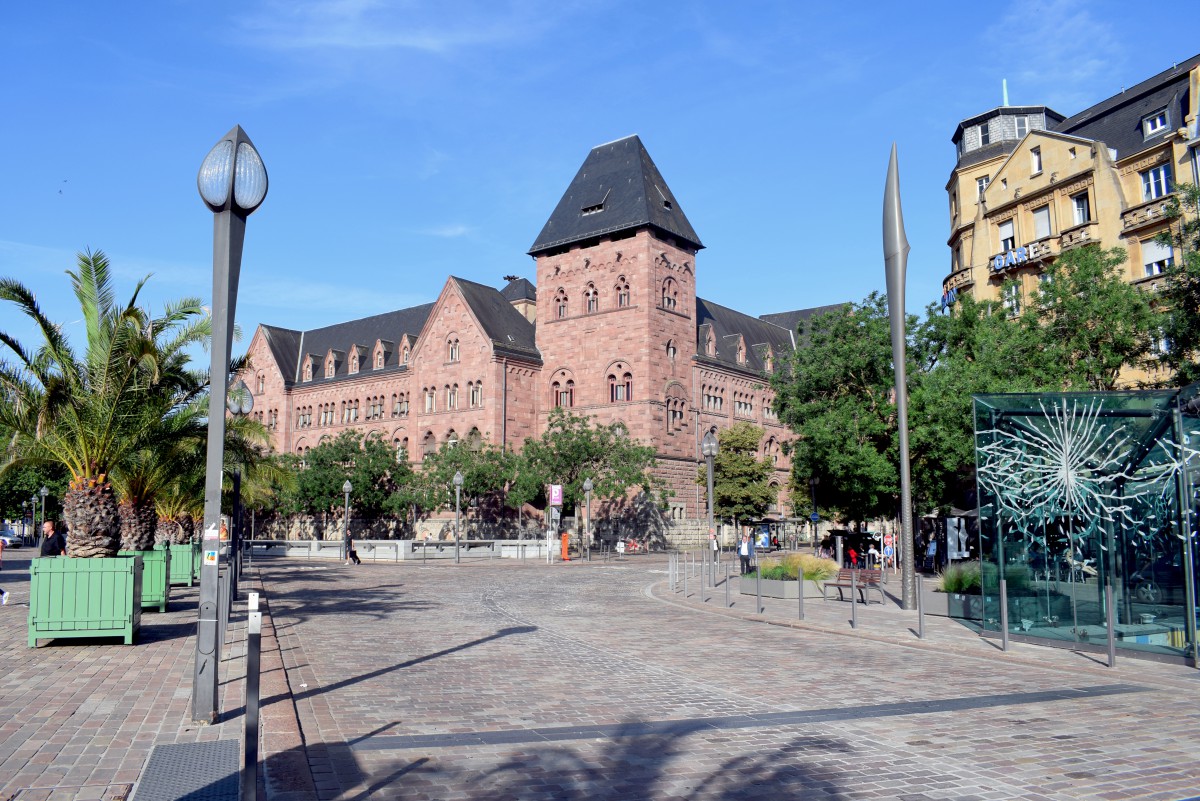
The iconic neo-Romanesque building of the Central Post Office of Metz was designed by architect Ludwig Bettcher and built between 1908 and 1911 on the Railway Station square.
With its pink sandstone colour and its round-arched windows, it is often the first building of Metz seen by the travellers coming out of the railway station.
The decision to locate the Post Office just opposite the railway station was motivated by efficiency.
Indeed, the speed of mail delivery is crucial, particularly in times of political tensions and war.
Although the facade is much less decorated than the railway station opposite the square, it contains a few fantastic or symbolic motifs on the top part of the columns.
Place Raymond-Mondon
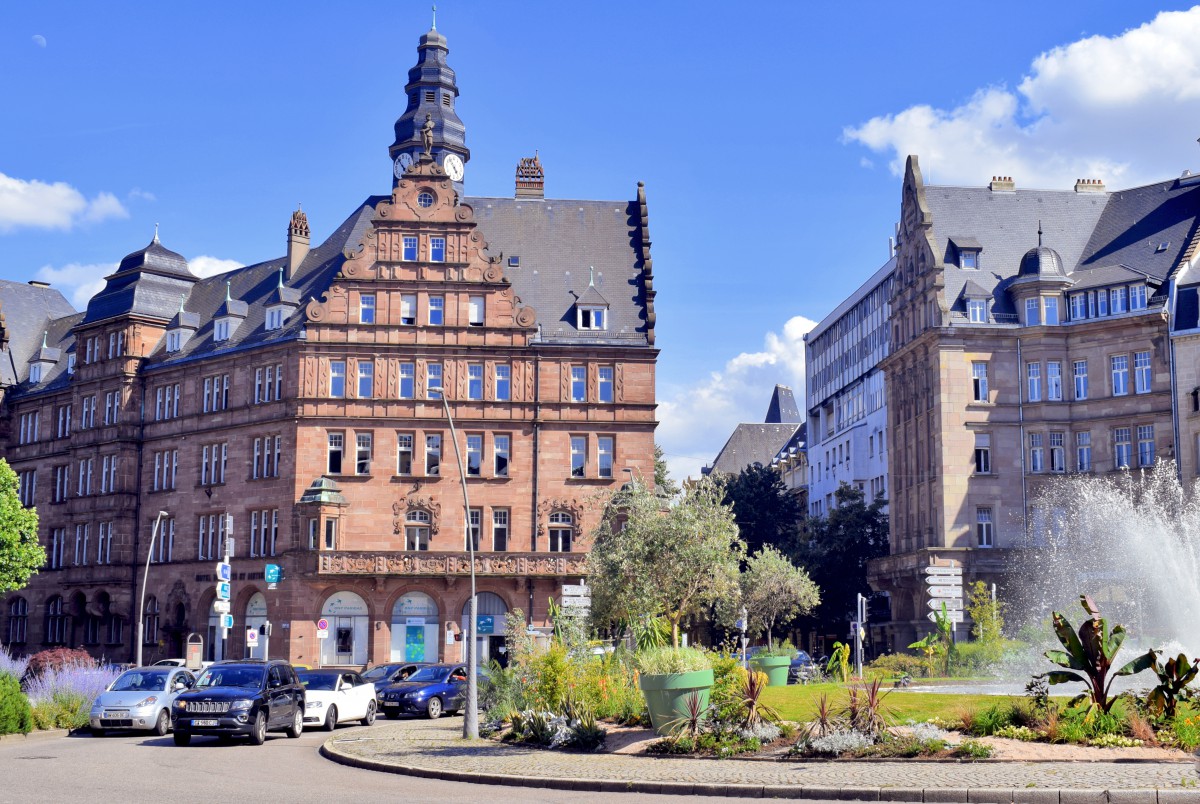
Place Raymond-Mondon is the former Imperial Square, built at the beginning of the 20th century, which portrayed the power of the Kaiser.
Its solemn facade opens towards the “Kaiser Wilhelm Ring”, now known as Avenue Foch. In its centre used to stand the equestrian statue of Wilhelm II’s father, Frederic III, unsurprisingly destroyed in 1918 when Metz became French again.
The pink sandstone buildings surrounding the square symbolised the influence of power around the Kaiser:
- the Imperial Bank (now the Chamber of Commerce),
- the Chamber of Trade (now a restaurant and a bank), and
- the Military power with the Prince Frederic Charles barracks.
The architects also planned to build a church to symbolise the religious power, however, it was never built due to the war.
Avenue Foch
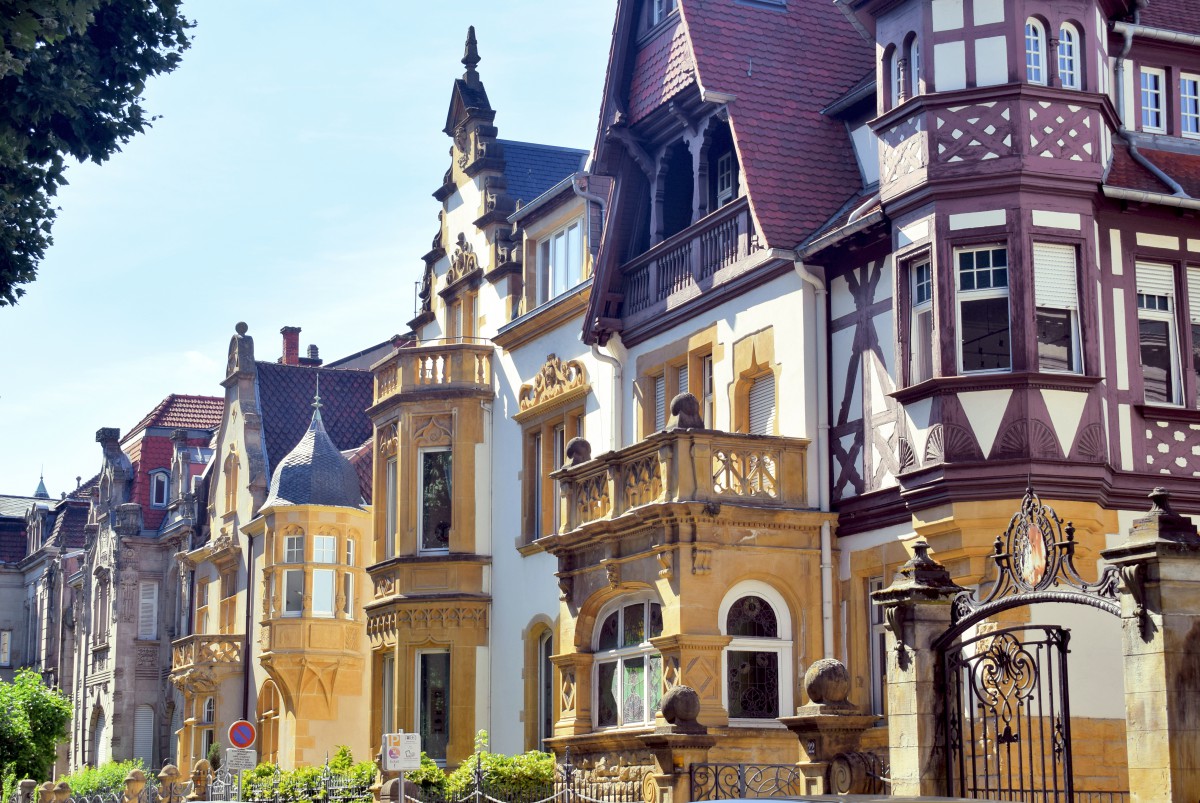
The large and chic avenue was obviously known by another name in the Prussian era: Kaiser Wilhelm Ring.
It was drawn around 1900 on the site of the city’s ramparts.
The urban regulation conferred a different status to the two sides of the road:
- the Southern side allowed business and trade buildings, restricted to 5 levels
- the Northern side was dedicated to rich decorated mansions surrounded by gardens, all limited to 3 levels in order to respect a certain harmonious transition with the older town of Metz.
The facades of the beautiful manors are worth discovering while strolling along the Avenue.
They display an interesting blend of architecture, Renaissance, neo-Romanesque or neo-Classical, mixed with elements of art nouveau, art deco (Jugendstil), Alsatian and Bavarian styles.
This majestic Avenue became a symbol of the modern and opulent new town erected by the German authorities. It was also used as an important route for the army as it allowed the soldiers to reach their barracks from the railway station.
The Palais du Gouverneur
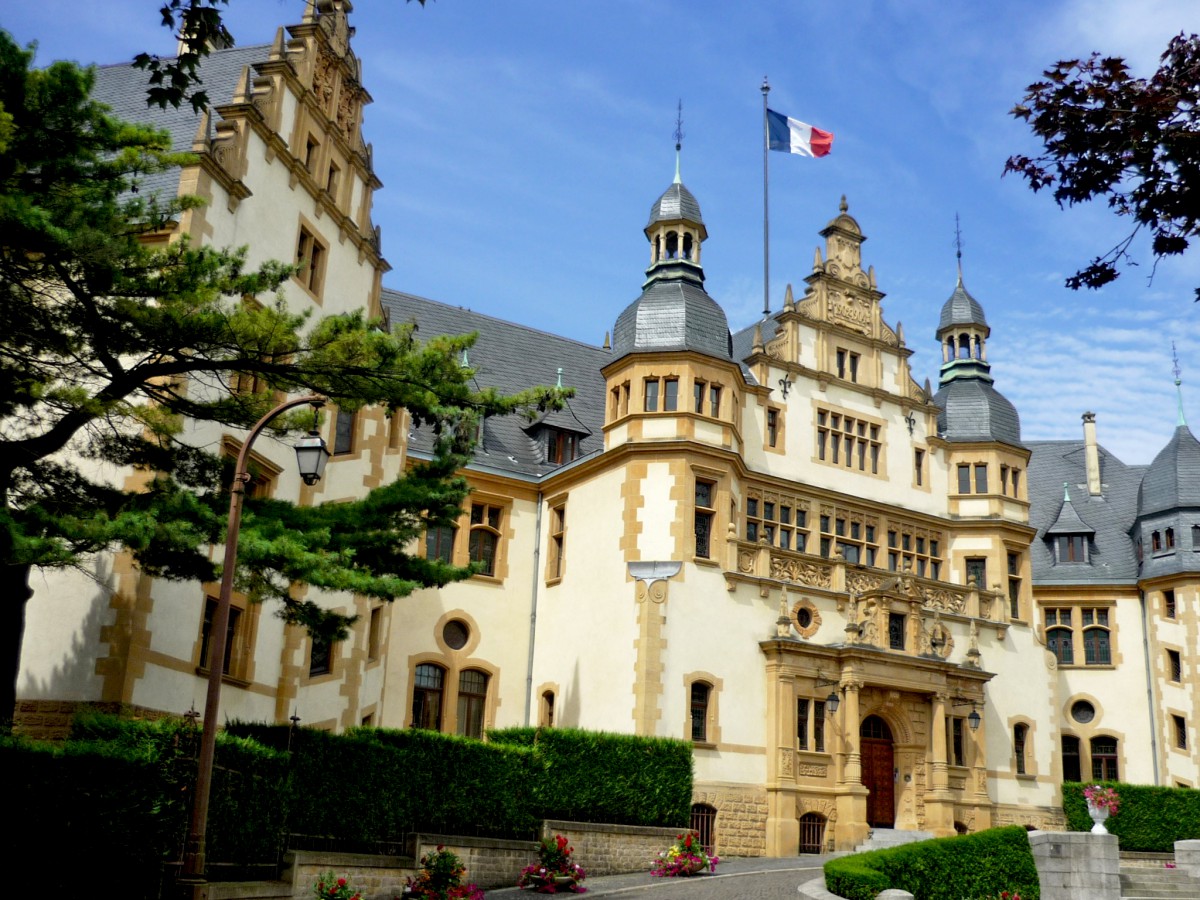
The Palais du Gouverneur of Metz has been listed as a historic monument in France since 1975. It was built between 1902 and 1905 to serve as a residence for Emperor Wilhelm II during his occasional visits to Metz.
The Palace was symbolically built on the site of the citadel erected by the French in 1552. When built, it was given the name “General-Kommando”. Its neo-Flemish style stands out against the surrounding buildings of Metz.
The mansion is still used for military purposes today as the headquarters of the Commander in charge of the North-East military region of France, including the French forces stationed in Germany.
To explore some of its 100 rooms, you will have to plan your visit to Metz in September for Heritage Day, the “Journée Portes Ouvertes des Monuments Historiques”. If you are lucky enough to get inside, make sure you look at the 1925 stained-glass windows by Michel Thiria, depicting the coat of arms of many regional towns, the sitting rooms, and the General’s office.
And not forgetting curiosities such as the enormous brown bear from Abkhazia offered in 1898.
In the private gardens are some remnants of the Roman rampart and the entrance to vast underground rooms which used to be part of the medieval Tour d’Enfer (Tower of Hell).
Set back from the German Imperial District are two impressive churches erected by the German between 1871 and 1914.
The Temple-Neuf
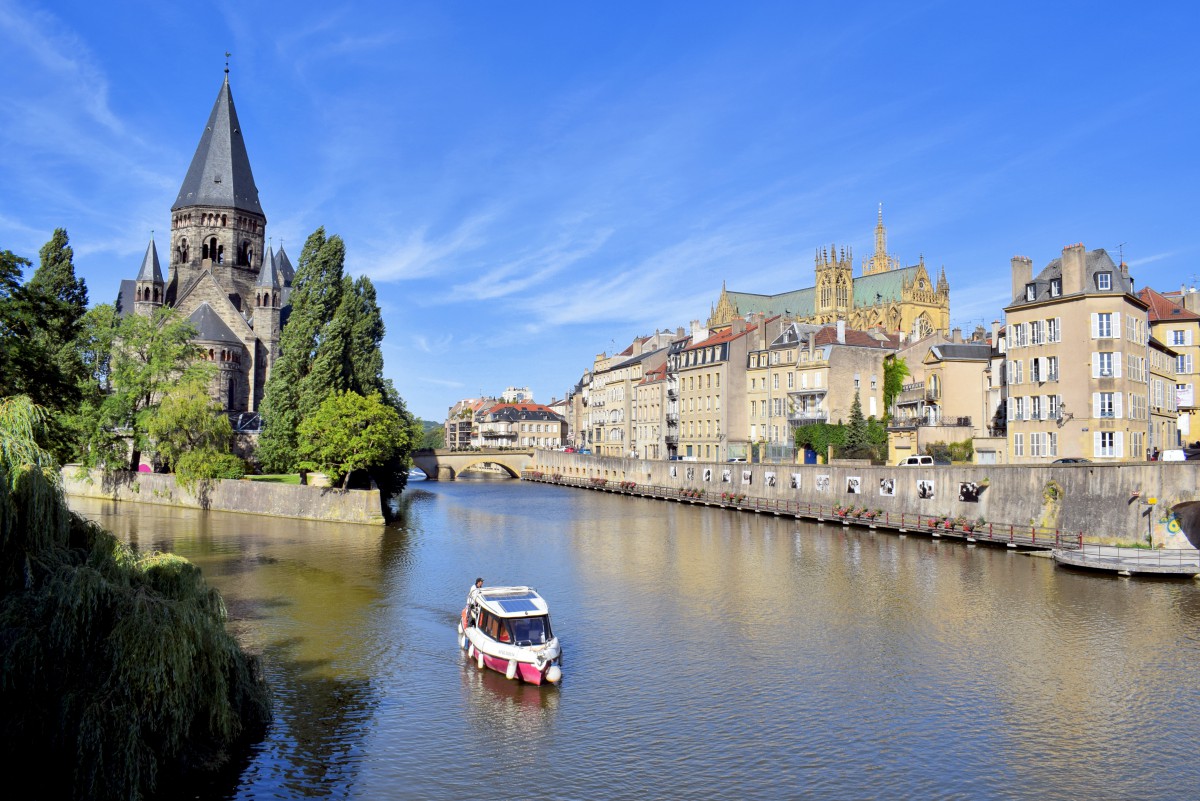
Set back from the District is the striking Protestant Temple Neuf. The neo-Romanesque church, built by architect Conrad Wahn, was inaugurated in 1904 by Kaiser Wilhelm II himself, who once again was there to assert the policy of Germanification of the Lorraine city.
Whether the Temple is seen from the Cathedral, the Place de la Comédie or from the pleasant view of the Moyen Pont, it surprises the eye by the contrast between the light honey-coloured stone of Jaumont and the dark colour of the Vosges limestone used for its construction.
Furthermore, it also stands out amongst the French classic buildings around it. Admire its neo-Romanesque style.
It features an octagonal lantern tower at the crossing of the transept.
The two bell towers were supposedly inspired by the Romanesque cathedral of Speyer in Rhineland Germany.
For this, many locals criticised the building as they were shocked by the lack of harmony with the classical buildings on Place de la Comédie.
Despite all this, the Temple Neuf has since become a distinctive and treasured landmark of Metz, which now celebrates the amicable relationship between France and Germany.
It now serves as a place of worship for the Reformed community of Metz.
The Temple of the German Garrison
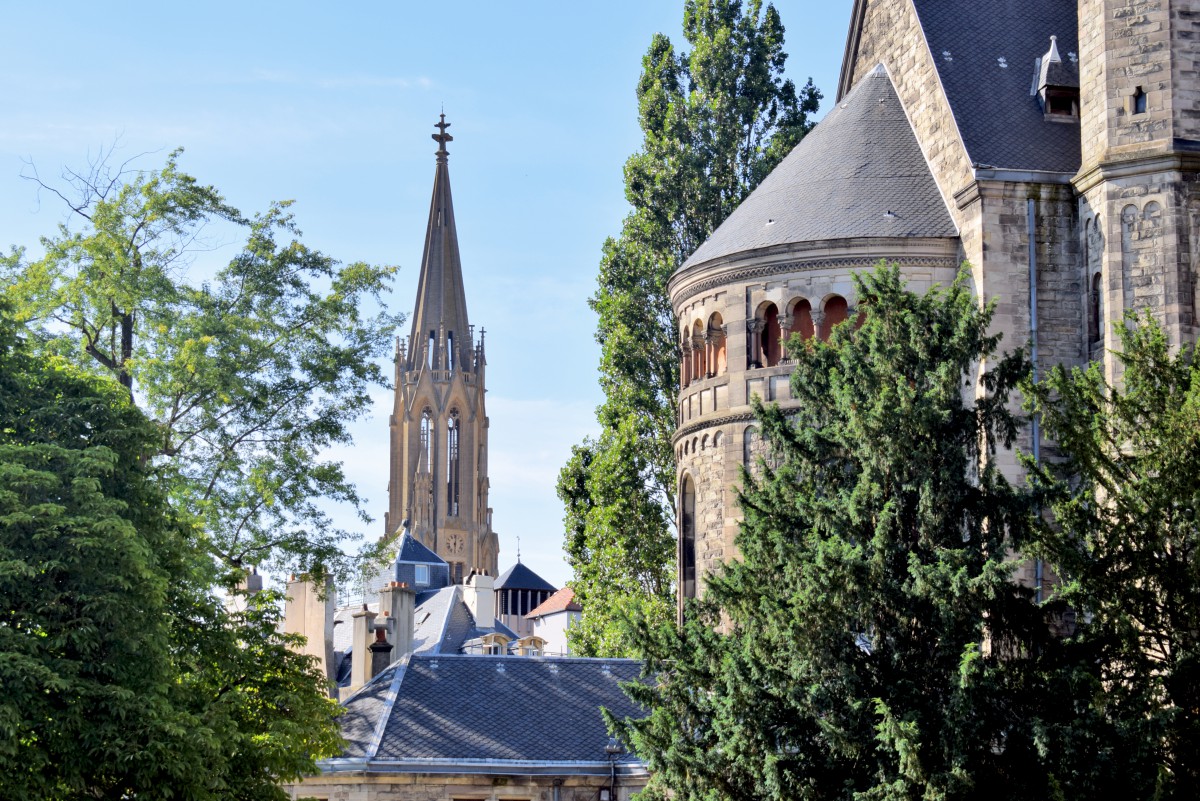
The Temple of the German garrison (Temple de Garnison) was built from 1875 to 1881 by German architect Rettig for the German soldiers of the Lutheran faith.
The neo-Gothic church initially had a nave and two side aisles, flanked by a central bell tower located on the facade.
Contrary to the later policy of the German authorities which would try to Germanify the city, the church was built in the neo-Gothic style with the honey-coloured stone of Jaumont.
However it did not take into account the wishes of the local population as it is reported that many were outraged when the spire challenged the Cathedral’s highest tower, overtaking it by one metre!
The Temple de Garrison was disused after the First World War and was eventually partially destroyed by the Allied bombings during the Second World War.
When the roof burnt in 1946, it was decided to only keep the bell tower as the structure of the church was no longer sound.
The imposing shape of the 91m high spire is now part of Metz’ skyline and has since been integrated into the Square du Luxembourg.
Proposing Metz to the UNESCO: a long procedure
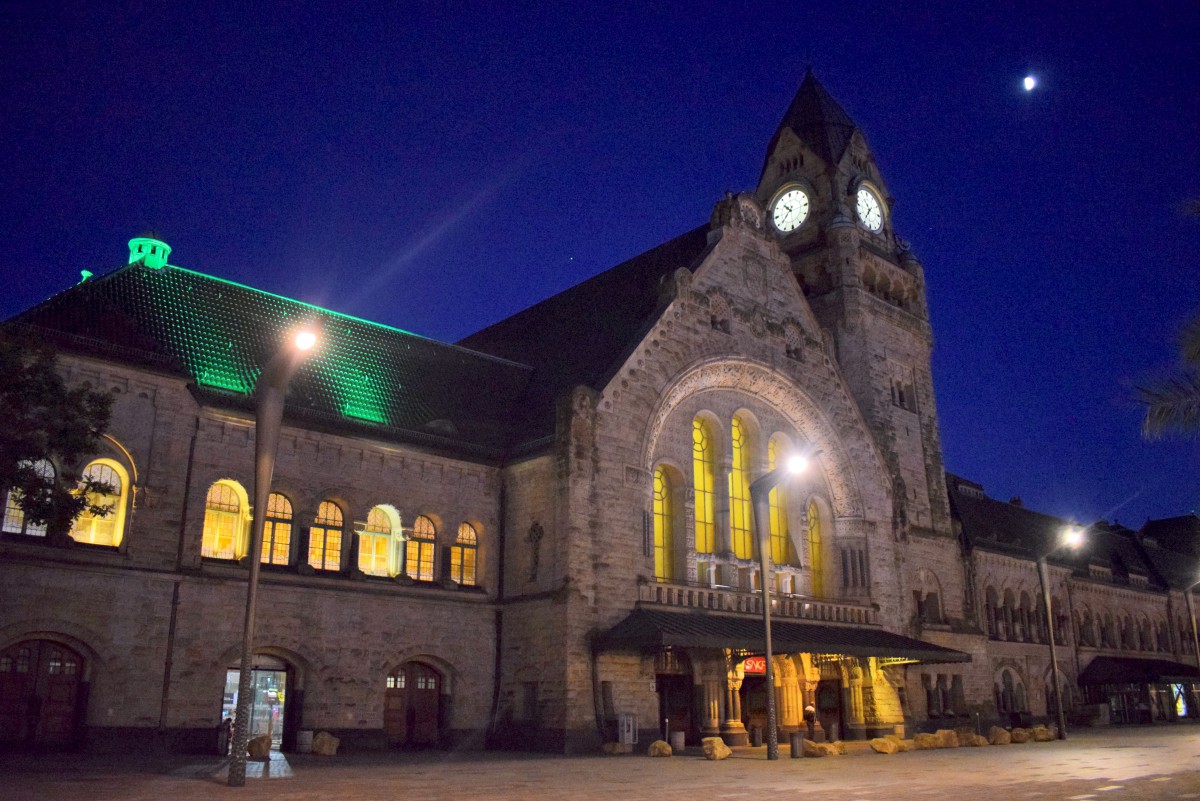
The demand of the municipality of Metz regarding the listing of its German Imperial District on the UNESCO World Heritage list tends to be a journey.
France, as for any signatory state of the UNESCO convention, holds an “indicative list” of sites it hopes to be recognised.
A country can only propose one site to the World Heritage program. The national list can be enriched at all times by adding suggested sites… the competition is hard for Metz as more than 40 sites are already on the French list!
Where to stay in Metz
When visiting Metz at the invitation of the city’s Tourist Board, I stayed in two different hotels that I’m happy to recommend. I found both of them very comfortable and ideally located in the centre of town.
Hôtel de la Cathédrale
As its name indicates, it faces the lofty cathedral of Metz!
>> Book your night at the Hôtel de la Cathédrale
AND
Hôtel Mercure Metz Centre
A comfortable and modern hotel with high standard rooms. Ideally located between the railway station and Metz old town.
>> Book your night at the Hôtel Mercure Centre
Other hotels and accommodations in Metz
Here’s a map that shows other accommodations in town:
Find out more about Metz
- All our 100% French written articles about Metz on the Mon Grand-Est blog
- The city’s Tourist board
- The Lorraine region Tourist Board
Inspired? Pin it for later:

